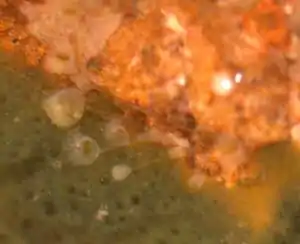
- Entoprocta
- Name Meaning: Inside anus
- English Common Name: Goblet worm
- Major distinguishing characteristics: Anus inside ring of cilia
- Approximate number of species described: about 150
Natural History
Goblet worms are sessile and aquatic. Adults are goblet-shaped on relatively long stalks. They have a "crown" of tentacles lined with cilia. The cilia generate water currents drawing food toward the mouth. The mouth and anus are both inside the "crown".
Some species are solitary, while others at colonial.
Taxonomy
The Phylum is divided into four families.
- Barentsiidae
- Loxokalypodidae
- Loxosomatidae
- Pedicellinidae
Anatomy
Adult entoprocts are goblet-shaped, with a relatively long stalk attaching the animal to a surface. They have a "crown" of 8 to 30 tentacles. The mouth and anus are on opposite sides of the area inside the crown. The digestive system is U-shaped, with a stomach near the bottom of the "U".
The Fossil Record
Goblet worms have a limited fossil record. They are soft-bodied and don't preserve well. The earliest fossil Entoprocta known today is a 520 million year old specimen from China. There is a similar animal from the Burgess Shale (505 myo), but it has been dismissed as not a true member of the Phylum.
Quiz
- Entoprocta Quiz
References and Further Reading
- Entoprocta at Wikipedia
- Entoprocta at Tree of Life
- Entoprocta at Encyclopedia of Life